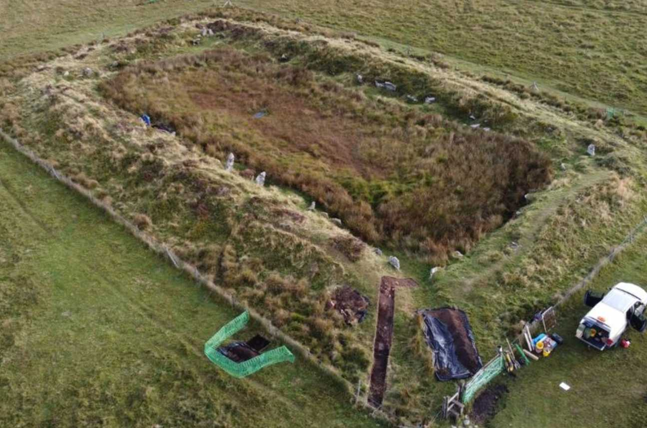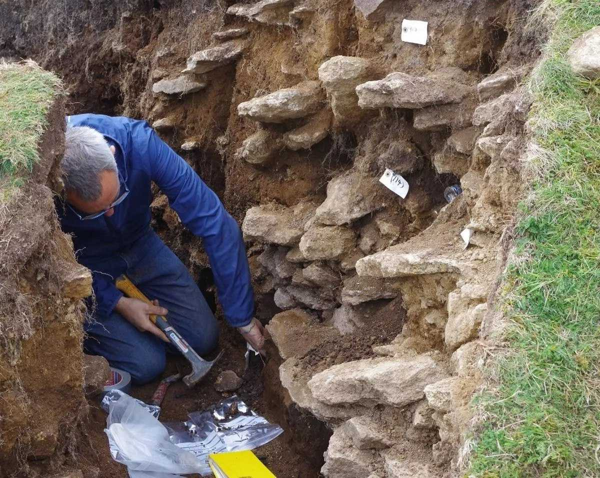King Arthur's Hall turned out to be a Neolithic livestock pen.
In the southwest of England, in Cornwall, lies Bodmin Moor — a marshy expanse surrounded by heather-covered wasteland. The oral tradition, later documented by Thomas Malory, connects Cornwall with the name of King Arthur.
It is here that the ruins of Tintagel Castle can be found, where, according to legend, the future ruler of Camelot was born. There, the wizard Merlin served King Uther Pendragon and later became the mentor to his son Arthur.
As Arthur grew up, he pulled the ancient sword from the stone, which made him king but did not provide him with a suitable weapon. The sword Excalibur was later given to him by the Lady of the Lake. This event took place at one of the marshy lakes of Bodmin Moor. After the Battle of Camlann, a mortally wounded Arthur commanded that Excalibur be returned to him.

In the late 19th century, shepherds discovered a strange structure on one of the remote hills of Bodmin Moor. At the top, they found a flat area measuring 47 by 20 meters, surrounded by an earthen embankment. The embankment was partially excavated, revealing that it contained 56 standing stones. Some of them had fallen, but it was clear that they once formed a complete perimeter.
Due to the general tradition linking the surrounding lands with the name of Arthur, the find was named the Hall of King Arthur. By the 20th century, archaeologists examined the hill and concluded that it could have been a temporary fortress where the elderly, women, children, and supplies, including livestock, were relocated in times of danger. Even in the listings of Historic England (the Commission for Historic Buildings and Monuments), this site was recorded as a medieval monument.
This year, excavations of the Hall of King Arthur were conducted by specialists from Cornwall Archaeological Unit and Historic England. Dating through radiocarbon analysis and optically stimulated luminescence was performed by scientists from the University of Reading (UK). They discovered that the structure was built by people at the end of the 4th millennium BC, during the Neolithic period.
This age of the monument fits well into the context: around it, on the moors of Bodmin, there are many ancient landmarks — from the foundations of roundhouses to cairns and burial stone boxes.
Archaeologists collected samples from the interior of the monument to identify the presence of fossilized remains of plants and animals, such as pollen, seeds, insects, and parasite eggs. After studying them, they concluded that the structure was initially used as a livestock pen.

Later, around 2000-2500 years ago, a significant portion of the monument was covered with earth. Judging by the deposits, a small reservoir may have been created there — although it remains unclear how the hydroengineers of the past managed to flood the top of the hill.
The standing stones were of local origin: they were gathered from the fields surrounding the hill. Whether these stones were erected at the initial stage of construction or added later remains unknown.
The repeated use of the site and possible modernization in later periods, including the medieval era, suggest that it retained cultural or functional significance for a long time after its initial construction.
Researchers noted that there are no known examples of stone-laid, flooded, and embanked Neolithic structures. They hypothesized that this was a sacred site for gatherings, rituals, or ceremonies. In this case, the flooding could have had a sacred character, justifying the effort spent on it.
During the early medieval period, people again began to rebuild the ancient livestock enclosure. As a result, some of the standing stones fell, and a small swamp formed inside the earthen embankment during the summer months.
According to the scientists, it is unlikely that the Neolithic hill in Bodmin Moor is directly connected to King Arthur. However, in British folklore, this is far from the first instance of clearly prehistoric structures being linked to the era of the legendary king. This may be related to the sacred significance of such places for people of various eras, from the Neolithic to the Middle Ages.